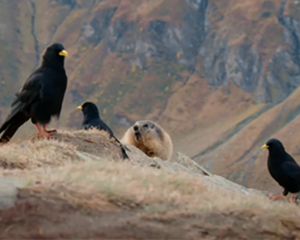Marmots are twice as fat now, as in the spring, are like stags who just lost one fifth of their body mass.
土拨鼠现在的体重是春天的两倍,就像刚减了五分之一体重的雄鹿。
For half a year, these Alpine rodents have stuffed themselves.
半年来,这些高山啮齿动物已经吃饱了。
Now it's time to make the den cozy for a long winter underground.
是时候把洞穴弄得舒舒服服地在里面度过漫长的地下冬天了。
To hold out six months underground, you want to comfy home.
想要在地下坚持六个月,家就得布置舒服了才行。
In this den, the male prepares the bedding. His mate supplies the hay.
在这家洞穴里,男方准备被褥,女方准备干草。
Out there it's risky. But as long as the chaffs are watching, one can relax.
出去是有风险的,但只要有干草在旁,就可以放松下来。

A safe well-furnished den is a marmot's dream, but it's not quite there yet. More padding is wanted.
一个安全、装修精良的洞穴是土拨鼠的梦想,但这个梦想还未实现,还需要更多的干草。
Even when the bed's perfect, with a restless bedfellow, a good rest is hard to get.
如果你有一个不安分的睡伴儿,那么床弄得再舒服你也难能休息好。
Marmots cozy up as families to keep warm.
土拨鼠一家窝在一起取暖。
The temperature inside the den decreases gradually from 60 degrees in autumn to freezing in spring.
洞穴内的温度从秋天的60度逐渐下降到春天的零度。
The animals also lower their body temperature down to about 40 degrees plus.
土拨鼠也会把自己的体温降到40度以上。
They survive on their bodies' storage of fat and water.
它们靠体内储存的脂肪和水分存活。
With thick layers of snow and soil on top, the entrance to their extensive den securely blocked, the Marmot is nature's paragon of bunker mentality.
土拨鼠身上覆盖着厚厚的积雪和土壤,通往它们宽敞巢穴的入口被安全地封锁起来,它们是自然界地堡心态的典范。
There's not the slightest strife down here, no matter how hard the store may blow outside.
不管外面的风刮得有多大,这里都不会受到任何干扰。












